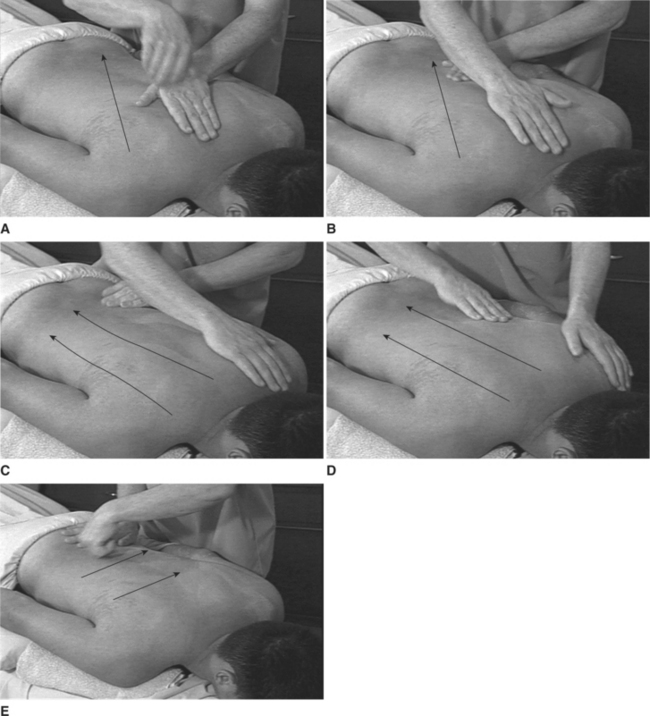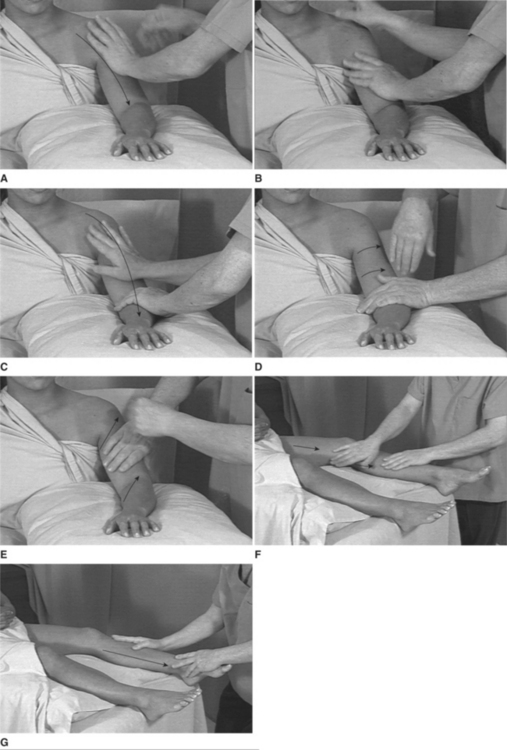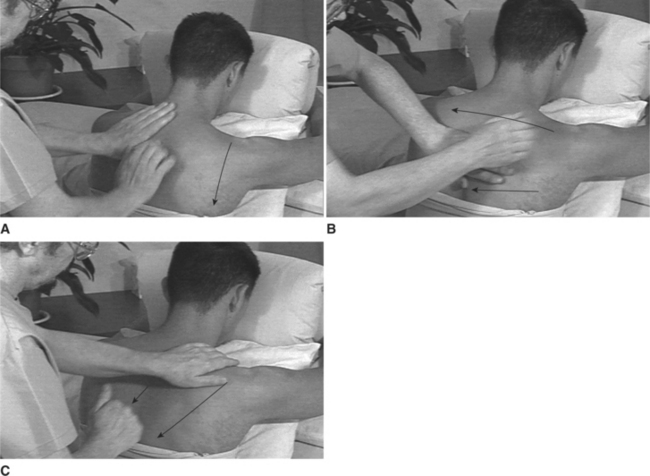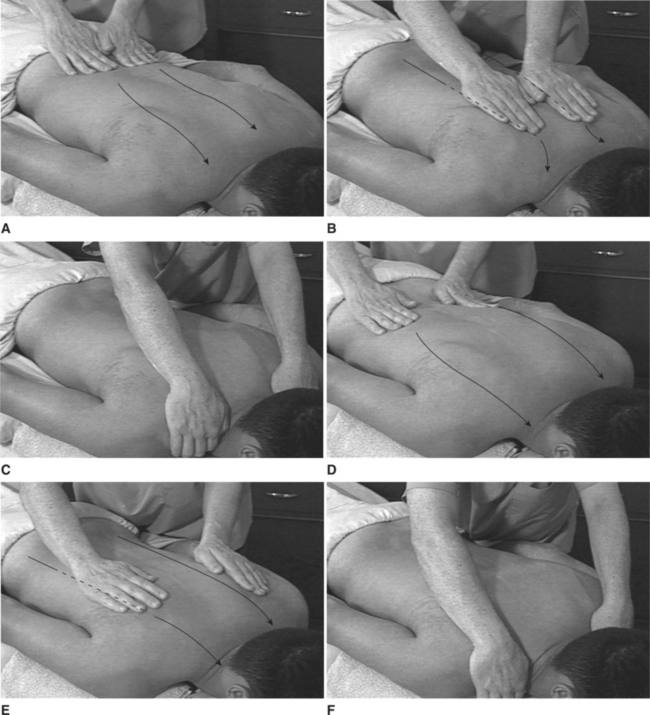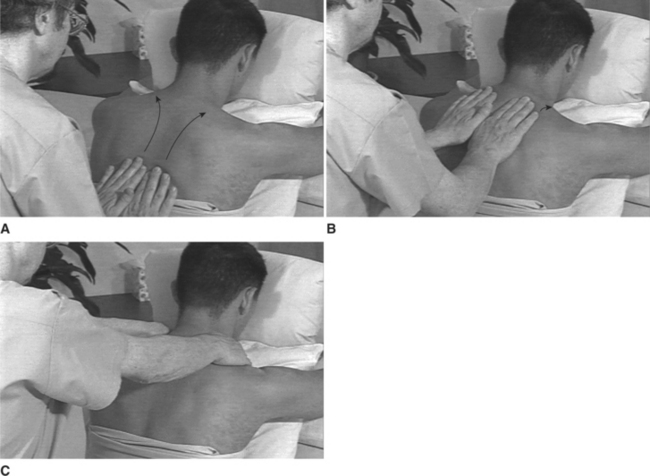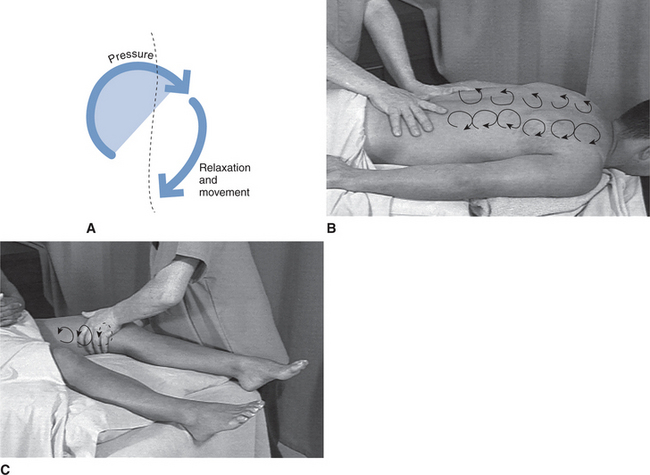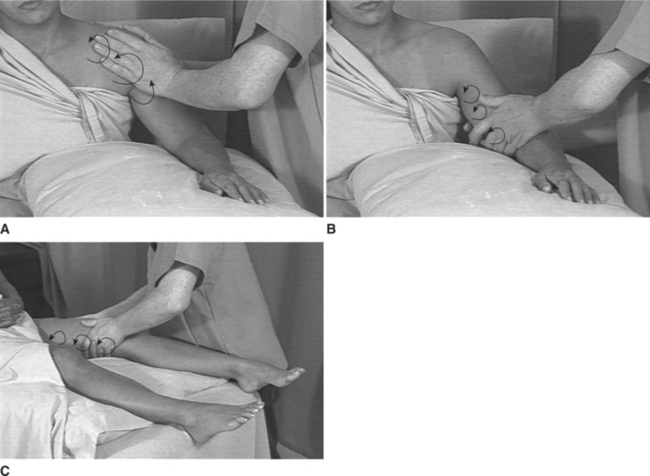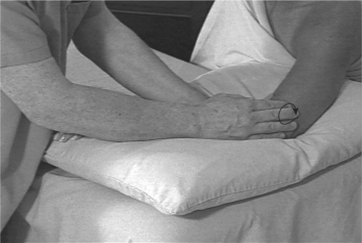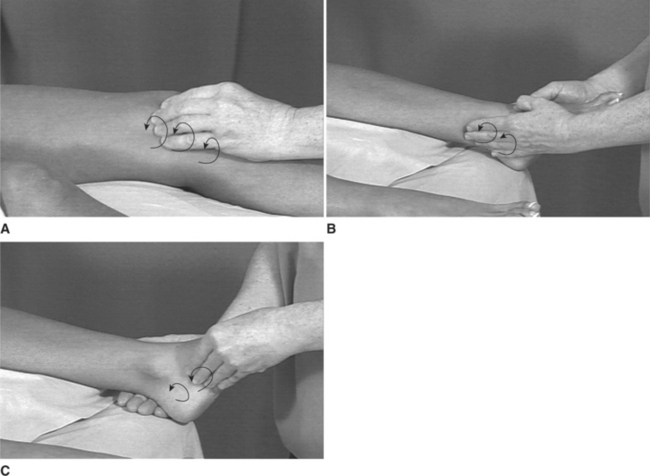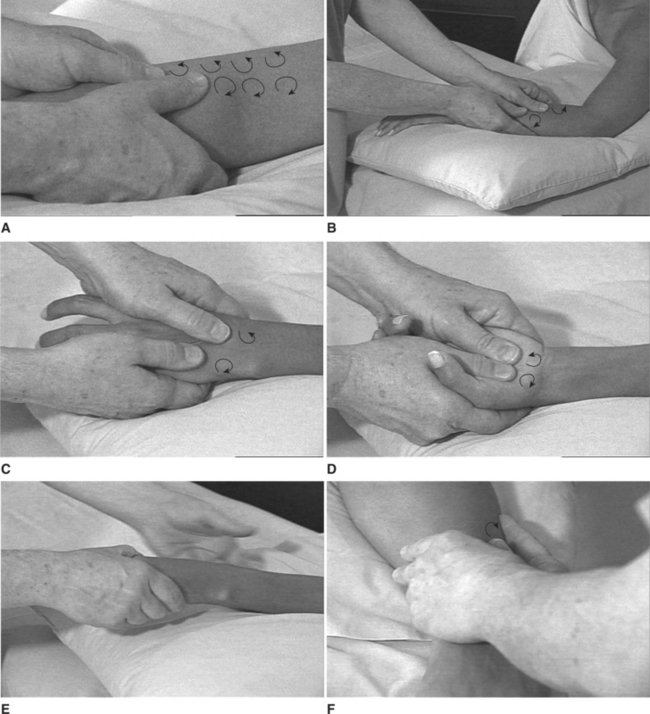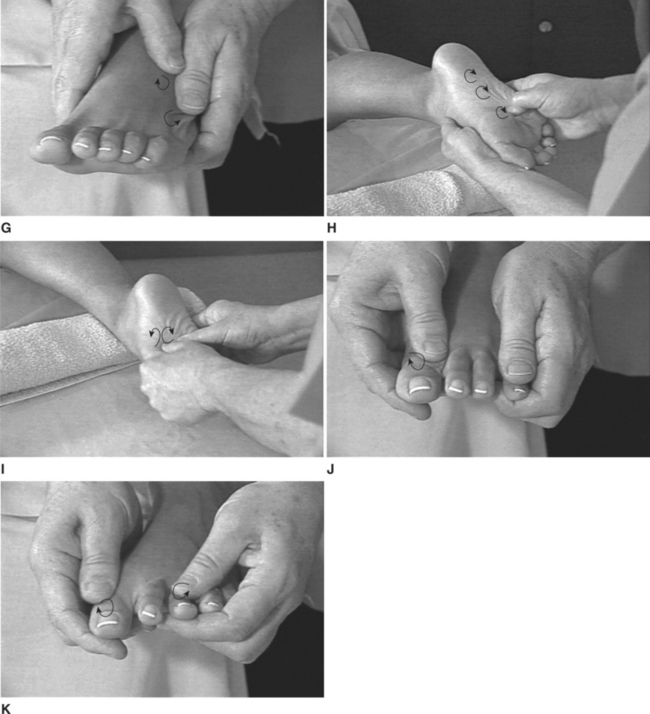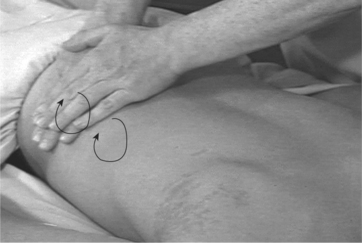Chapter 4 Classification, Definitions, and Descriptions of the Basic Massage Strokes and Relaxed Passive Movements
As the brief history of massage presented in Chapter 1 revealed, there have been, and still are, many different ways of defining the various massage techniques. This chapter provides specific information about each of the traditional massage strokes that are based on the system known as Swedish remedial massage. The definitions and descriptions represent a current view of the various techniques. Of course, some of the descriptions of the strokes are at variance with earlier ones. This is not surprising, given the considerable disagreement over massage terminology used in the past. Indeed, it is hoped that the classification and descriptions detailed in this chapter are logical, accurate, and worthy of adoption. In most cases, photographic examples are given of each of the strokes to several body parts, and many of these strokes are also featured in Chapters 7 and 8, which address general and local massage techniques.
What then are the soft tissues of the body? Essentially, the soft tissue of the body comprises all structures that are not a direct part of the skeleton. Thus, the bones, and therefore the joints, can be considered as the hard tissues, together with articular and fibrous cartilage. In addition, the teeth, fingernails, and toenails can be classified as hard tissue. Although there is an entire discipline of manual therapy dedicated to mobilizing and manipulating the joints, one can argue strongly that even these techniques are directed at the soft tissues rather than the bones and joints themselves. The bones and joints do not bend and stretch during or in response to these techniques. Instead, it is the soft tissues surrounding the joints (skin, capsules, ligaments, tendons, etc.) that are affected, together with those muscles whose tendons span the joints being treated. A simple classification of soft and hard tissues is shown in Table 4-1.
Table 4-1 A Classification of Soft and Hard Tissues
| SOFT TISSUES | HARD TISSUES |
|---|---|
| Skin | Bones |
| Subcutaneous tissues | Teeth |
| Muscles | Finger and toenails |
| Tendons | Articular and fibrous cartilage |
| Ligaments | |
| Joint capsules | |
| Nerves | |
| Blood vessels | |
| Lymph vessels | |
| Heart and lungs* | |
| Abdominal organs* | |
| Pelvic organs* | |
| Brain* | |
| Eyes* |
* These structures/tissues are soft tissue in nature but cannot be massaged because of their anatomical locations.
Some of the structures/tissues listed in Table 4-1 are soft tissue in nature but cannot be massaged because of their anatomical locations (e.g., brain, heart, lungs). Although soft tissue manipulation can affect the abdominal viscera in a general way, it cannot be applied directly to a specific abdominal or pelvic organ. Clearly then, soft tissue manipulation can have an effect on almost all tissues of the body. Many of these effects are discussed in Chapter 5. There are a variety of techniques that can be considered as types of soft tissue manipulation, and these are listed in Box 4-1.
Recreational massage is defined as follows:
Therapeutic massage is defined as follows:
In addition to these major distinctions, it may be helpful to define three basic ways in which therapeutic massage may be given to a patient. A specific chapter in the text is devoted to each of these concepts. In each case, various techniques are combined to form a massage sequence, and these may be given to the entire patient (Chapter 7), to one or more regions of the body (Chapter 8), or to a specific anatomical structure (Chapter 9).
General massage is defined as follows:
Local massage is defined as follows:
Focal massage is defined as follows:
CLASSIFICATION OF MASSAGE STROKES
Individual massage strokes can be classified in a number of ways. Here, they are grouped on the basis of the way in which each one is performed (e.g., a pressure stroke). Individual strokes are classified as described in Table 4-2.
Table 4-2 A Classification of Massage Strokes
| MANIPULATION (STROKE) | VARIATIONS |
|---|---|
| Stroking manipulations | Stroking |
| Effleurage | |
| Pressure manipulations (pétrissage) | Kneading |
| Picking up | |
| Wringing | |
| Skin rolling | |
| Percussion manipulations (tapotement) | Hacking |
| Clapping | |
| Beating | |
| Pounding | |
| Vibration and shaking | |
| Deep frictions | Transverse |
| Circular |
STROKING MANIPULATIONS
Stroking
Deep Stroking
Figures 4-1, 4-2, and 4-3 show the different directions for the technique of stroking. In addition, the DVD demonstrates stroking on several body areas.
Primary Effects of Stroking
Therapeutic Uses of Stroking
When included in a treatment sequence, stroking can be used to do the following:
Contraindications to the Use of Stroking
The general concept of contraindications is covered in Chapter 3. As a technique, stroking may be contraindicated when any of the situations listed in Table 4-3 are present.
Table 4-3 Main Contraindications to the Use of Stroking
| Large open areas (e.g., burns or wounds) in the areas to be treated, especially if they are infected | A |
| Gross edema in the areas to be treated if there seems to be a possibility of splitting the skin | A |
| Cancer in the skin or any other tissue in the area to be treated | A |
| Serious infections in the tissues to be treated (tuberculosis, septic arthritis, etc.) | A |
| Lacerations, bruising, infections, or foreign bodies (e.g., glass, grit, metal) in the skin of the area to be treated | A |
| Acute or chronic skin conditions affecting the areas to be treated (e.g., psoriasis, eczema, or dermatitis) | U |
| Marked varicosities in the areas to be treated if damage to the vein wall might result (very light stroking may be possible) | U |
| Within 3 to 6 months following radiation therapy in the area to be treated (skin is usually hypersensitive) | U |
| Areas of hyperesthesia in the areas to be treated (i.e., those who are very sensitive/ticklish to touch) | R |
| Extremely hairy areas in the areas to be treated (if stroking causes pain) | R |
A, Always contraindicated; U, usually contraindicated; R, rarely contraindicated.
Effleurage
Depth and Pressure
Effleurage to a variety of body areas is depicted in Figures 4-4 throuh 4-6. In addition, on the DVD effleurage is demonstrated to several body areas, as noted in the following table.
Primary Effects of Effleurage
Therapeutic Uses of Effleurage
When included in a treatment sequence, effleurage can be used to do the following:
Contraindications to Effleurage
The general concept of contraindications is covered in Chapter 3. As a technique, effleurage may be contraindicated when any of the situations listed in Table 4-4 are present.
Table 4-4 Main Contraindications to the Use of Effleurage
| Large open areas (e.g., burns or wounds) in the areas to be treated, especially if they are infected | A |
| Cancer in the skin or any other tissue in the area to be treated | A |
| Serious infections in the tissues to be treated (tuberculosis, septic arthritis, etc.) | A |
| Gross edema in the areas to be treated if there seems to be a possibility of splitting the skin | A |
| Lacerations, bruising, infections, or foreign bodies (e.g., glass, grit, metal) in the skin of the area to be treated | A |
| Chronic swelling in the areas to be treated, in the lower limb associated with severe congestive cardiac failure or any other heart condition with which lower limb edema is associated | U |
| Acute or chronic skin conditions affecting the areas to be treated (e.g., psoriasis, eczema, or dermatitis) | U |
| Marked varicosities in the areas to be treated if damage to the vein wall might result (very light stroking may be possible) | U |
| Within 3 to 6 months following radiation therapy in the area to be treated (skin is usually hypersensitive) | U |
| Areas of hyperesthesia in the areas to be treated (i.e., those very sensitive/ticklish to touch) | R |
| Extremely hairy areas in the areas to be treated (if stroking causes pain) | R |
A, Always contraindicated; U, usually contraindicated; R, rarely contraindicated.
PRESSURE MANIPULATIONS
Pétrissage
Kneading
Definition
Kneading is a manipulation in which the muscles and subcutaneous tissues are alternately compressed and released. The technique produces movement in a circular direction. Each circular movement is divided into two roughly equal phases: compression and relaxation accompanied by a sliding movement of the hands, fingers, or thumbs. During the pressure phase of each stroke, the therapist’s hands (or fingers or thumbs) and the skin move together on the deeper structures. During the release (relaxation) phase, the hands (or fingers or thumbs) glide smoothly to an adjacent area of tissue where the movement is repeated.
Basic Technique and Direction of Movement
Kneading is a stroke in which the therapist’s hands and the patient’s skin move together on the deeper structures whenever pressure is applied to the tissues. It can be performed with several parts of one or both hands, including the entire palmar surface and the pads/tips of the fingers or thumbs. In each case, the basic direction of the movement is circular. Pressure is applied during half of the circular motion and released with relaxation during the other half. Although kneading can be performed in a stationary manner (stationary kneading), it is more usual for the hands to move across the body surface during the technique. Movement of the hands is achieved during the relaxation phase of each circular motion. The hands usually move in parallel lanes to cover the entire area to be treated. The larger the area, the more lanes are needed. This type of kneading compresses the tissues and is therefore known as palmar kneading. Several variations of the technique can be used, and these will be considered in a later section. Figure 4-7 illustrates the concept of circular motion and movement in parallel lanes. It is common to most, but not all, types of kneading.
Variations
Palmar Kneading.
When the entire palmar surface is used, the technique may be called palmar kneading. The basic palmar kneading stroke is also called compression kneading, circular kneading, flat-handed, and whole-hand kneading. In this manipulation the tissues are compressed upward and inward in a circular motion against the underlying tissues and then released. Overlapping lanes of circular strokes are used to cover a large area of the body, such as the back. If the tissues are flat, such as the back region, both hands can be used on the same plane of motion (side by side). In the limbs, however, the hands usually work opposite to each other (on either side of the limb). This produces more movement of the whole muscle masses involved.
Figures 4-8 and 4-9, A, illustrate the basic two-handed technique. The techniques shown in Figure 4-9 are good examples of the therapist’s hands working opposite each other and out of phase. Palmar kneading, using one- and two-handed techniques, is also demonstrated on the DVD.
Finger Pad Kneading.
This technique is also called digital kneading, and it involves the basic palmar kneading stroke performed with one or more finger pads, using one or both hands. If the therapist’s hands are placed opposite each other, for example, around the knee region, then the finger pads usually work in phase with each other. It is quite possible, however, for the finger pads to work out of phase, and this is simply a matter of preference. The technique is useful for treating small- to medium-sized areas and areas of irregular shape (e.g., around the elbow, knee, or ankle). When both hands are used, they may work side by side in some situations, or opposite each other, as in Figures 4-10 and 4-11, which illustrate finger pad kneading around the elbow and knee regions, respectively. Finger pad kneading is also demonstrated on the DVD (see DVD Chapters 4-31, 4-48, 4-51, and 4-63).
Thumb Pad Kneading.
The basic palmar kneading stroke can also be performed with the pads of one or both thumbs, usually working side by side. This technique is especially useful along fusiform muscles (e.g., the flexors and extensors of the wrists and fingers or the anterior tibial muscles). It is also useful for the treatment of small areas in the hand, foot, and face. Figure 4-12 illustrates the stroke. Thumb pad kneading is also demonstrated to various body areas on the DVD (see DVD Chapters 4-35, 4-37, 4-50, 4-52, and 4-64, 4-65, 4-66).
Reinforced Kneading (Palmar Thumb Pad or Finger Pad).
As its name might imply, reinforced kneading is a two-handed technique in which one hand reinforces the other. The basic palmar kneading technique is performed with one hand on top of the other, to reinforce the pressure of the stroke. It can be particularly useful for treating the lumbar region in large or very muscular patients, especially when extra effort would be required for effective treatment. This is especially true if the therapist is of relatively small stature and the patient is very large. The technique is illustrated in Figure 4-13 to the lumbar region. The technique can also be viewed at DVD Chapter 4-5.

